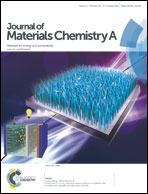The effect of a solid electrolyte interphase on the mechanism of operation of lithium–sulfur batteries†
Abstract
Composite sulfur–carbon electrodes were prepared by encapsulating sulfur into the micropores of highly disordered microporous carbon with micrometer-sized particles. The galvanostatic cycling performance of the obtained electrodes was studied in 0.5 M Li bis(fluorosulfonyl)imide (FSI) in methylpropyl pyrrolidinium (MPP) FSI ionic-liquid (IL) electrolyte solution. We demonstrated that the performance of Li–S cells is governed by the formation of a solid electrolyte interphase (SEI) during the initial discharge at potentials lower than 1.5 V vs. Li/Li+. Subsequent galvanostatic cycling is characterized by a one plateau voltage profile specific to the quasi-solid-state reaction of Li ions with sulfur encapsulated in the micropores under solvent deficient conditions. The stability of the SEI thus formed is critically important for the effective desolvation of Li ions participating in quasi-solid-state reactions. We proved that realization of the quasi-solid-state mechanism is controlled not by the porous structure of the carbon host but rather by the nature of the electrolyte solution composition and the discharge cut off voltage value. The cycling behavior of these cathodes is highly dependent on sulfur loading. The best performance at 30 °C can be achieved with electrodes in which the sulfur loading was 60% by weight, when sulfur filled micropores are not accessible for N2 molecules according to gas adsorption isotherm data. A limited contact of the confined sulfur with the electrolyte solution results in the highest reversible capacity and initial coulombic efficiency. This insight into the mechanism provides a new approach to the development of new electrolyte solutions and additives for Li–S cells.


 Please wait while we load your content...
Please wait while we load your content...